Like many countries, Cambodia’s food culture has been shaped over centuries by the rise and fall of empires, colonization, and modern upheavals. My first introduction came in elementary school, when we studied the country from the Khmer Empire all the way to the modern era. I did a project on Angkor Wat, presenting what I learned to the class. Later, during my travels, it was incredible to make my way to Siem Reap and Angkor Wat in person. I spent hours wandering the temple complexes, in awe at seeing in person what I had previously only read about. Though the trip did also gift me one of the most embarrassing moments of my travels.

Alongside these ancient temples, Cambodia also carries more recent and painful history. In grade six, we read about the Khmer Rouge regime of the late 1970s, when Pol Pot’s government imposed forced labor, starvation, and violence that killed nearly two million people — close to a quarter of the population. That period left deep wounds still felt today, and it’s impossible to think about Cambodia without acknowledging both the glory of its past and the scars of its more recent history.
This is a food guide, though, so I will save the deeper history for another post. Traditional Cambodian (Khmer) cuisine centres on rice, freshwater fish, pork, and a wide variety of vegetables and fresh herbs. Signature flavours often come from spice pastes (called kroeung) made with lemongrass, galangal, turmeric, lime leaves, garlic, and shallots, along with a fermented fish paste called prahok.
For gluten free travellers, Cambodia traditionally uses fewer gluten-containing ingredients than other countries in the region, but there are still some key dishes and ingredients to watch for. Below, I’ll highlight what to look for, what to avoid, and some classic dishes you can enjoy while (as always) being mindful to avoid soy sauce and wheat noodles. Others can be adapted with few adjustments.
I hope you enjoy your time in the country as much as I did!

What should celiacs know when traveling to Cambodia?
As a celiac, it is important to be proactive when planning a trip to Cambodia to ensure that you have access to safe and gluten free food options. Here are a few things to consider:
- Be aware of cross-contact risks: As with dining elsewhere in Asia, foods fried in the same woks, or same grill, may create risks for celiacs.
- Read up on safe street food dining: After years of eating on the street, I wrote a guide to eating at food stalls safely, which doesn’t refer to gluten but to choosing stalls that will minimize any risks of food-borne illness or stomach upset. These rules apply to any country I’ve visited, and have helped me avoid getting sick on the road.
- But in those stalls, beware of sauces, especially soy sauce, oyster sauce, or bouillon cubes: as mentioned above, soy sauce is less prevalent in Cambodia than it was during my years of living in Thailand, but it nonetheless has a role in food in the country, especially in sauces. It may be worth bringing small packets of your own soy sauce, but even if you don’t please ask about the sauces when getting street food.
- Bring a detailed gluten free card for Cambodia. Yes, I made my own, because existing ones weren’t as detailed as I needed as a sensitive celiac. (See below) These cards made my travels better and less stressful, and also served as a connection point to springboard larger conversations in tourist areas who were curious about the condition and what happens when I eat gluten. Bad things. Bad things happen.
- Amok is where it’s at. I ate many amok in my time in Cambodia. Most frequently prepared with fish, it not uncommon to see it with chicken or pork. This dish is traditionally gluten free (and delicious), but as always confirm before you consume. It’s served with steamed rice.
- Try to eat at the beginning of peak hours, to communicate your needs. When traveling with a food restriction or allergy, communicating your needs is imperative, and doing so when someone has the patience to read your card is also sometimes a challenge. When in markets or at street stalls, or even restaurants, I tried to go just when they opened so that I could present my card and explain what I needed but not during their big rush period for dining. A crowded food stall won’t likely have the time to cater to me mid-dinner or lunch rush; it was always better received — and more fruitful! — to be strategic about when I visited. You don’t want to go late off-peak because the food will have been sitting out for hours, as my Street Food Guide above notes. Heading there early always made it easier for me.
A detailed gluten free restaurant card for Cambodia
This detailed Khmer gluten free restaurant card will help communicate your eating restrictions, and allow you to understand what is safe and unsafe from the menu.
Note: The card is available for purchase via Gumroad, a trustworthy 3rd party site that uses Stripe, so you know your information is safe.
Why is this gluten free card for Cambodia different?
I used several different translation cards on my travels, and I still got sick. I may be more sensitive than some celiacs, but even a small amount of oil for frying that had contact with gluten, or wheat-thickened sauce in the food, is enough to make me ill for days. Let alone the joint pain later that week, and the fatigue. And regardless of whether we feel it or not, ingesting any amount of gluten is a problem if we are celiac.
Why choose a Legal Nomads detailed gluten free restaurant card?
✅ Each card is carefully crafted by someone with celiac disease, and then goes through 2 sets of translations to ensure accuracy.
✅ Unlike shorter, less-detailed cards, each card it lists out local ingredients and dishes that have hidden (and not hidden!) gluten in them. Saying “I can’t have gluten” just isn’t usually enough to keep celiacs safe — many people preparing your food don’t know what ingredients have gluten in them.
✅ It expressly mentions that we cannot eat food from pans, shared fryers, or cooking surfaces that have had cross-contact with gluten.
✅ To ensure the card is taken seriously, it adds an apology for the inconvenience, and emphasizes that avoiding gluten is a medical obligation — not a choice.
✅ It is instantly downloadable in both PNG and printable PDF file formats, to help you eat safely as you travel.
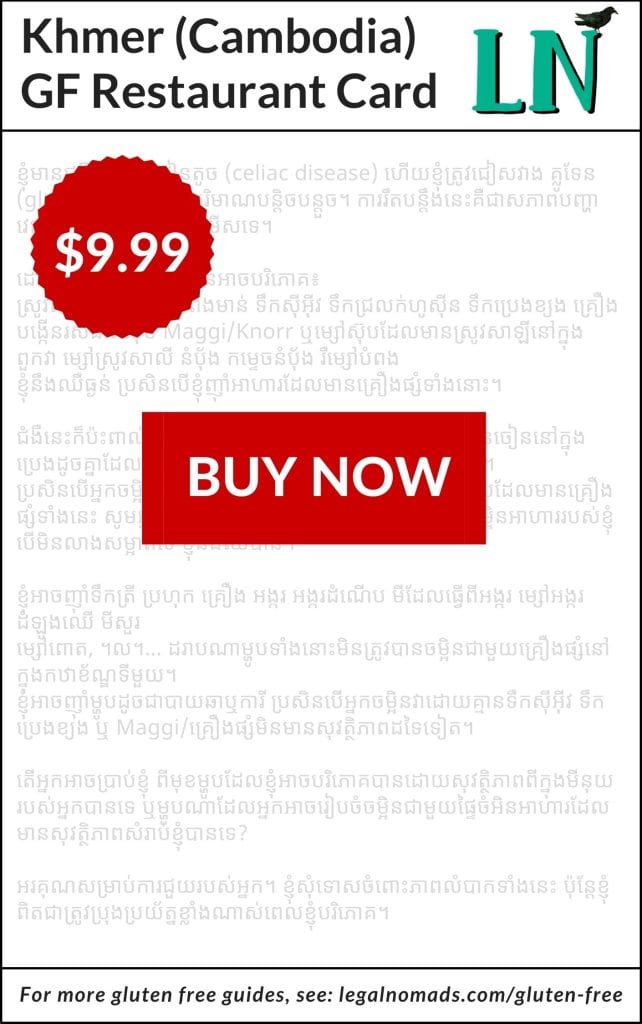
Eating gluten free in Cambodia: dishes, desserts, and more
Base ingredients
The following ingredients are used commonly in Cambodian food, and are safe for celiacs unless the recipe has been changed. (It’s always important to double check!). I’ve also included some base veg and fruit ingredients.
- Fermented fish sauces: these include plain fish sauce (ទឹកត្រី), mam (salt, roasted red sticky rice and palm sugar to snakehead fillets and fermenting them for more than a year), prahok (with shrimp added, more of a paste than mam), and kapi (fermented fish with sugar, garlic, lime juice, chilli and crushed peanuts, often used as a dipping sauce for vegetables, fruit, meat and fish.
- Tamarind sauce: made from tamarind fruit, and delicious. Usually tamarind pulp, sugar, water, and sometimes fish sauce.
- Kroeung is a fresh paste frequently used as a base for curries, soups and stir-fries, and is one of the essential ingredients of Cambodian cuisine. There are five common types of kroeung: yellow kroeung, green kroeung, red kroeung, as well as k’tis kroeung, and saraman kroeung. Most common ingredients, present in these pastes, are lemongrass, magrut (sometimes called Kaffir lime) zest and leaves, galangal, turmeric, garlic, shallots, dried red chilies and galangal. Different ratios, and addition of other seasonings, differentiate the different pastes. These are traditionally gluten free. If you’re buying kroeung from a supermarket, do confirm no additional wheat was added.
- Green leafy vegetables: there are many delicious leafy greens in Cambodia, but often they are cooked with soy or hoisin sauce. You’ll need to make sure yours aren’t. These vegetables are commonly included in soups and salads, though, and the most popular ones are: morning glory (ត្រកួន), cabbage (ស្ពៃក្តោប), Chinese kale (ខាត់ណាចិន), vine spinach (វល្លិ៍ជន្លង់), and watercress (ច្រាច់).
- Fruit: You can’t visit Cambodia and not try as many amazing fruit as possible. Safest options in terms of potential GI distress are ones you can peel and eat. My faves include mangosteen (មង្ឃុត), sweet sapodilla (សាប៉ូឌីឡា), milk fruit (ផ្លែទឹកដោះគោ), dragon fruit (ស្រការ), pomelo (ផ្លែក្រូចថ្លុង, phlê kroch thlŏng), and rambutan (សាវម៉ាវ). Try these alone, or in a fruit smoothie – you can’t go wrong.
Noodle soups
Noodle soups are my favourite part of Cambodian cuisine, and the best breakfast I could ever ask for. Many are traditionally gluten-free, relying on rice noodles and broths crafted from simmered bones, herbs, and spices. However, modern soupmaking, as we’ve seen in other countries, doesn’t always stick to traditional recipes. Some street vendors and restaurants use bouillon cubes to speed up broth preparation, and brands like Knorr and Maggi often contain wheat. Soy sauce is another common shortcut for seasoning. Because of this, it’s important to ask vendors whether soy sauce or bouillon cubes were used in the broth, or show your celiac translation card to do so.
- Kŭytéav (គុយទាវ) similar to hủ tiếu in Vietnam, a popular Chinese-Cambodian breakfast of rice vermicelli soup with meat (chicken, beef or pork) in a clear broth, topped with bean sprouts, chopped scallions, chopped coriander, fish sauce, lime, and sriracha. Includes a dry version, much like hu tiu as well, called kŭytéav kouk (dry kŭytéav). Traditionally, the receipt does not have soy sauce (but does use fish sauce), however many vendors have been adding it to the broth; please confirm when ordering.
- Kŭytéav khor ko (គុយទាវខគោ), a braised beef stew with rice noodles made with flat rice noodles, potatoes, chives, carrots, as well as shallots, garlic, lemongrass, magrood leaves, galangal, star anise, chili, carrots, and sawtooth herb. Similar to Vietnam’s hủ tiếu bò kho, but traditionally without the soy sauce. Confirm: no soy in the preparation, and decline the hoisin topping and the bread that accompanies it.
- Num banhchok (នំបញ្ចុក) a breakfast soup of lightly fermented rice noodles with a fish gravy made from prahok and yellow kroeung topped off with fresh mint leaves, bean sprouts, green beans, banana flowers, cucumbers and other greens. There is also a red curry version usually reserved for ceremonial occasions and wedding festivities. Traditionally gluten free.
- Num banhchok Kampot (នំបញ្ចុកកំពត): Cold rice noodles instead of soup are the star of this Kampot dish, served a variety of herbs, ground nuts, pork, and fish sauce. Traditionally gluten free.
Other soups, stews, and curries
- Amok; most commonly fish amok (អាម៉ុកត្រី, amŏk trei): A Khmer steamed fish curry where the fish fillets are rubbed with kroeung mixed with coconut cream or coconut milk and eggs and steamed in a banana leaf container. It is served on a banana leaf, and eaten with steamed rice. While it is typically fish you can also find versions with chicken or beef, or sometimes tofu / vegetarian options. This was a reliable meal for me throughout my stay. Note that you’ll need to confirm the kroeung is gluten free.
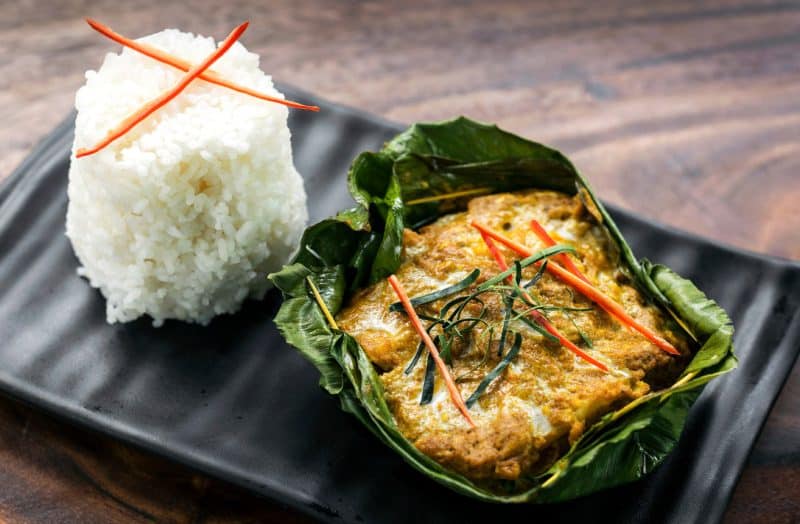
- Num banhchok samlar kari (នំបញ្ចុកសម្លការី) A rice noodle dish eaten with a Khmer curry soup. The curry may be yellow (turmeric soup base) or red (chilli curry soup base) depending on the type of soup created and generally include chicken (including legs) or beef, potatoes, onions, and carrots. Traditionally gluten free.
- Congee (បបរ) White rice porridge, with or without meat (chicken, pork, fish, dried fish, seafood, snails, or frog legs) served with a wide array of condiments (fish floss, pickled vegetables, fried garlic, fish sauce, chilli flakes, chilli oil, and fresh herbs). Confirm that meat is not marinated in soy sauce.
- Hot pot (ឆ្នាំងភ្លើង) Safe if: (1) there is no soy sauce or wheat-containing bouillon in the broth, (2) none in the marinade for meat/tofu, and (3) no wheat noodles are used.
- Pickled lime soup with chicken (ស្ងោរមាន់ង៉ាំង៉ូវ) A very unique tasting chicken and vegetable soup flavoured with pickled limes or lemons. The limes are pickled for weeks (or even months), and impart such a tangy flavour that makes you come back for more. Recipe is traditionally safe; confirm that no soy sauce was used in the broth, or bouillon cubes.
- Samlor prahal (សម្លប្រហើរ, literally translates to ’fragrant soup’) Another unique soup, this one a popular staple of Cambodian villages. It’s made using a lemongrass paste made with ginger, and has a variety of veggies like squash, taro, or pumpkin, as well as lemon basil. It’s not a vegetarian soup as it usually has fish, but can be made into a vegetarian version as the fish is usually added after the soup is cooked.
- Samlar machu (សម្លម្ជូរ) Samlar are a group of sour soups, where the sourness can come from tamarind or lemon basil or a combination of this and lime juice. Similar to canh chua in Vietnam, some versions of them have tomato, pineapple, fish, and herbs (e.g. samlar machu Khmer Krom). There’s also samlar machu kroeung (featuring kroeung, turmeric, water morning glory, coriander, stewed beef ribs and tripe). Recipe is traditionally safe; confir, no soy sauce or unsafe bouillon used.
- Samlar kako (សម្លកកូរ): Traditional Cambodian stirring pot soup, one of Cambodia’s national dishes. It consists of green kroeung, prahok, roasted ground rice, catfish, pork or chicken, vegetables, fruits and herbs safe
- Samlar prahal (សម្លប្រហើរ): A fish soup flavoured with prahok and a kroeung made from lemongrass, turmeric, fingerroot and garlic. safe
- Saraman curry (ការីសារ៉ាម៉ាន់): A beef curry similar to Thailand’s Massaman curry. Recipe is traditionally safe; confirm no soy sauce was used.
- Kari sach moan (ការីសាច់មាន់): A red curry with chicken, not to be confused with Thai red curry that is far spicier! Khmer red curry is made with a milder red chili, kroeung, sweet potatoes, coconut milk, and daikon. It can be served with a baguette, so be sure to ask for it with rice noodles instead.
Stir-fries and rice dishes
Stirfries are normally off limits due to the soy sauces used, however there are a few dishes that are traditionally made gluten free, or can be modified as such:
- Chicken rice (បាយមាន់): If Hainanese chicken had a baby with kroeung curry paste. Delicious. Fish sauce traditionally used, but confirm no soy sauce was added, and broth is free of bouillon cubes.
- Kampot pepper crab (ក្តាមឆាម្រេចខ្ជី): Stir-fried crab with garlic, spring onions, ground Kampot black peppercorns or Kampot green peppercorns, fish sauce and herbs. Recipe is traditionally safe; confirm no soy sauce or unsafe bouillon used.
- Fried rice (បាយឆា, bay cha): Like elsewhere in Southeast Asia, many different versions and proteins exist for fried rice. While soy sauce is less prevalent than Thailand, for example, it’s often used in fried rice. Ask for it with fish sauce, and confirm cross-contact concerns are addressed / a clean wok is used.
- Bay sach chrouk (បាយសាច់ជ្រូកោ / pork rice): A popular breakfast dish, it consists of rice and pickled vegetables served alongside thinly-sliced pork that is marinated in fish sauce and sugar, then grilled. Often comes with a bowl of chicken broth topped with fried scallions, so we must confirm several things: that the marinade has no soy/oyster sauce, and that the fried onions have no flour or cross-contact with the oil that was used. I often just asked for no fried onions.
Salads, sides, and steamed foods
- Banana flower salad (ញាំត្រយ៉ូងចេក): Shredded chicken, banana flowers, roasted peanuts and herbs and vegetables with a dressing made out of garlic, chillies, fish sauce, lime juice and palm sugar. Recipe is traditionally safe; confirm no soy sauce was used. (Salads are called nhoam in Cambodia, and usually consist of herbs and an uncooked base like the banana flower, pomelo, or green papaya, below, as well as small dried shrimp, fresh herbs, and fish sauce).
- Fresh spring rolls (ណែម): What North Americans call ‘summer rolls’, these rice paper rolls filled with meat and vegetables and often rice vermicelli noodles are served cold. These are similar to Vietnamese gỏi cuốn rolls. Dipping sauce may be off limits, however; confirm no soy sauce or oyster sauce.
- Green papaya salad (បុកល្ហុង): A salad from garlic, bird’s eye chili peppers, dried shrimp, pickled crab, papaya, green beans and tomatoes pounded in a mortar and pestle and mixed with Holy basil, coriander or long coriander and makrut lime leaves, as well as a savoury dressing of lime juice and fish sauce, and garnished with peanuts. Like Thailand’s som tam, but less spicy. Recipe is traditionally safe; confirm no soy sauce, Maggi or oyster sauce was used.
- Rice noodle rolls (គុយទាវកាត់ ‘cut flat rice noodles’): Like Vietnamese bánh cuốn, these are steamed rice and tapioca flour rolls with minced pork and mushroom filling, cut into smaller pieces in Cambodia. Recipe is traditionally safe; confirm no soy sauce was used and that the batter is 100% rice flour.
- Chive cakes (នំកាឆាយវៃ) Delicious Cambodian street food snack made from glutinous rice flour, tapioca flour, chopped chives and garlic, fried in a large pan. Recipe is traditionally safe; confirm no wheat flour in the batter, and that the oil did not have cross-contact with something that has gluten. Decline the dipping sauce, as it has gluten, and use your own GF soy sauce.
- Coconut-rice crêpes (បាញ់ឆែវ, num banh chao): Crêpes made from coconut milk, rice flour and turmeric. Eaten with ground pork, lettuce leaves, carrot-chilli sauce and roasted peanuts. Similar to bánh xèo in Vietnam. Recipe is traditionally safe; confirm no wheat flour in the batter, and that the oil did not have cross-contact with something that has gluten.
- Coconut pancakes (នំគ្រក់, num krok): A delicious street food snack made from a mixture of coconut milk, rice flour and scallions cooked on a cast iron griddle with half-spherical moulds. Recipe is traditionally safe; confirm no wheat flour in the batter.
- Num ansom (នំអន្សម) are Cambodian sticky rice cakes wrapped in banana leaves that are steamed and available in sweet and savoury options. The sweet version has sticky rice with banana and coconut milk, whereas the savoury is often filled with meat and mung beans. It’s such a quintessentially Cambodian dish that the Guiness Book of World Records was set for the biggest one ever made — you can see pictures here. As with steamed rice cakes used in Vietnam for Lunar New Year, people in Cambodia make these as well for bigger holidays in the country.
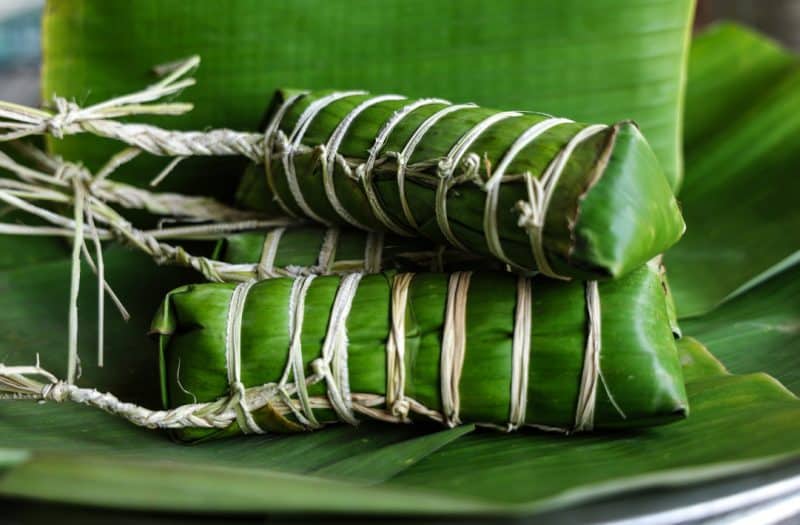
- Tuk kroeung not to be confused with kroeung of curry pastes, above, this is a traditional Cambodian dip made of prahok (fish paste), cooked fish, and aromatic herbs, usually served with a plate of lightly blanched vegetables for dipping.
Sweets
- Sticky rice with sesame seeds (នំទ្រាប): A slightly hardened glutinous rice and coconut dessert topped off with roasted sesame seeds.
- Cambodian doughnuts (នំកង): These are rice flour pastries made with coconut milk that are glazed with palm sugar and garnished with sesame seeds. Sold in markets and usually eaten as a to-go breakfast food. Recipe is traditionally safe; confirm no wheat flour in the batter, and that the oil did not have cross-contact with something that has gluten.
- Pandan rice cakes (នំបាញ់ឌុក, num banh duc): A dessert made with pandan, rice flour and tapioca. Recipe is traditionally safe; confirm no wheat flour in the batter.
- Coconut waffles (នំពុម្ព, num poum): Waffles made from rice flour and coconut milk. Recipe is traditionally safe, but more and more wheat flour is sneaking in. Please confirm no wheat flour in the batter.
- Pandan tapioca balls or sweet tapioca balls (គុជខ្យងតាហ្គីកា) flavoured with pandan leaves and salt. Recipe is traditionally safe; confirm no wheat flour in the batter.
- Num krolan (នំក្រឡាន) Sticky rice steamed in a bamboo tube, a popular street food snack in some areas of the country.
- Pumpkin-coconut custard (សង់ខ្យាល្ពៅ, sankya lapov): A dessert made of steamed pumpkin filled with coconut flan. Recipe is traditionally safe; confirm no wheat flour in the custard.
- Durian or mango sticky rice: A sticky rice dessert topped with sweet coconut milk and slices of durian or mango fruit.
- Banana coconut tapioca pudding (ចេកខ្ទិះ)A Khmer porridge made out of sago or tapioca pearls, slices of banana, coconut milk and palm sugar and garnished with grated coconut and toasted white sesame seeds. AMAAZING. Traditionally safe.
- Green bean porridge (បបរសណ្តែកខៀវ): A dessert made from tapioca, mung beans, sugar, and coconut milk.
- Longan pudding (បបរមៀន): A pudding made out of coconut milk, palm sugar and tapioca topped with fresh longan. Recipe is traditionally safe; confirm no wheat flour used.
- Num lot: A green or white dessert made from rice flour in a liquid of coconut, milk, water and sugar, similar to Indonesian cendol.
- Pandan coconut jelly (សារាយខ្ទិះ): A dessert with layers of pandan and coconut agar jelly.
- Red lotus seed jelly: A coconut milk-based dessert with water chestnuts covered with tapioca, served with sweetened coconut milk and shaved ice.
- Sweet corn porridge (បបរស្ករពោត): Sweet corn kernels and glutinous rice boiled in coconut milk sweetened with palm sugar.
Unsafe dishes in Cambodia: where to find the gluten
- Dumpling noodle soup (មីគាវ) sadly off limits, as most dumplings in the world are. The wontons are made from wheat, and noodles are often wheat as well.
- Caramelized pork and eggs (ខសាច់ជ្រូក, khor săch chrouk): Braised pork and egg stew flavoured in caramelized palm sugar, fish sauce, and Kampot black peppercorns.
- Egg cakes (នុំពងៃ, num pɔɔng): Wheat donut deep-fried and flaked with milk.
- Num pang (នំបុ័ង – ‘bread‘): It is similar to Vietnamese bánh mì.
- Num pao (នំប៉ាវ): leavened dumplings made with wheat flour.
- Spring onion bread (នំប៉័ងចិន, num pang chen): Flat, baked bread with spring onions, similar to Chinese-style scallion pancakes.
- Fried spring rolls (ចៃយ៉, chai yor or ណែមចៀន, naem chien): A Cambodian version fried spring rolls made with a wheat wrapper.
- Pak lov (ផាក់ឡូវ, pak ḷūv)” A dish of caramelized/braised organs made with oyster sauce and often soy sauce.
- Stir-fried wheat vermicelli (ឆាមីសួ, cha mee sua): Wheat vermicelli stir-fried with garlic, vegetables, mushrooms, and oyster, fish, and soy sauce.
- Stir-fried hand-pulled noodles (មីឆា, mee cha): Hand-pulled wheat noodles often stir-fried with beef and vegetables, and topped with an egg and gravy. A common street food, but mee are made with wheat and the sauce has oyster sauce.
- Cantonese noodles (មីកាតាំង, mii kaatang): Stir-fried flat rice noodles in soy sauce and oyster sauce with eggs, carrots, Chinese kale, and marinated meat (pork, beef, chicken, shrimps or mixed seafood.
- Cambodian-style barbecue pork: A Cambodian rendition of the Chinese char siu barbecue pork that is often added to baguettes or eaten with rice for breakfast.
- Num por pia (នុំពពៀ, num pɔpəə): Available with a variety of stuffings, these are made from a wheat spring roll wrapper that is deep fried.
Gluten free restaurants and shops in Cambodia
Select gluten free items are often available scattered throughout supermarkets targeting Western shoppers. Try one of the branches of Lucky Supermarkets, or the supermarket at Aeon Mall in Phnom Penh. Also worth a shot are the 24-hour Super Duper supermarkets in Phnom Penh, which carry a selection of goods from Australia and the U.S. Smile mini marts in Phnom Penh carry some gluten free items, including soy sauce. Best of all, they are open 24 hours.
Veggy’s in Phnom Penh is a small gourmet grocery shop with fresh produce and international non-perishables. They usually have a few gluten free foods in stock, as well as dairy free and vegan products. Daily Meat in Kampot is a small grocery shop that now sells gluten free bread (plain, and caramelized onion).
Gluten free restaurants in Phnom Penh
- Elia Greek has three locations in Cambodia, two in Phnom Penh and one in Siem Reap. The restaurant serves delicious Greek traditional foods, many of which are safe. (Many dips, however, are not!) Their menu notes allergens other than gluten, and offers gluten free options that include rice instead of pita. Exercise caution as there is a risk of cross-contact, and confirm no CC with the oil if opting for fries.
- Pu Rock Cafe does not have a gluten free menu, but the owner is knowledgeable and happy to accommodate. They also have gluten-free soy sauce available on request. A lovely mix of Western and Khmer dishes here.
- David’s Noodle does not have a gluten free menu but offers curries and rice paper noodles that are gluten free. The fried rice without soy sauce is an option as well. Confirm no CC.
- Flavours of India does not have a gluten-free menu, but as with many of my gluten free guides, Indian restaurants offer safe options around the world. Many of their curries and biryani are gluten free; ask to confirm which are safe.
- Backyard Cafe is an organic, vegan / vegetarian restaurant. They do not have a dedicated gluten free menu, but gluten-free dishes are clearly marked. There are dishes like salmon zucchini fritters, black bean wraps, and banana dough mini donuts. All of their smoothies are delicious and gluten free. Confirm no CC with the oil used.
- Juniper Gin Bar & Kitchen does not have a gluten free menu, but pizzas can be made with a gluten free base, with a pan underneath to protect the dough for GF diners. While many have not had issues here, there is a risk of CC, so exercise caution.
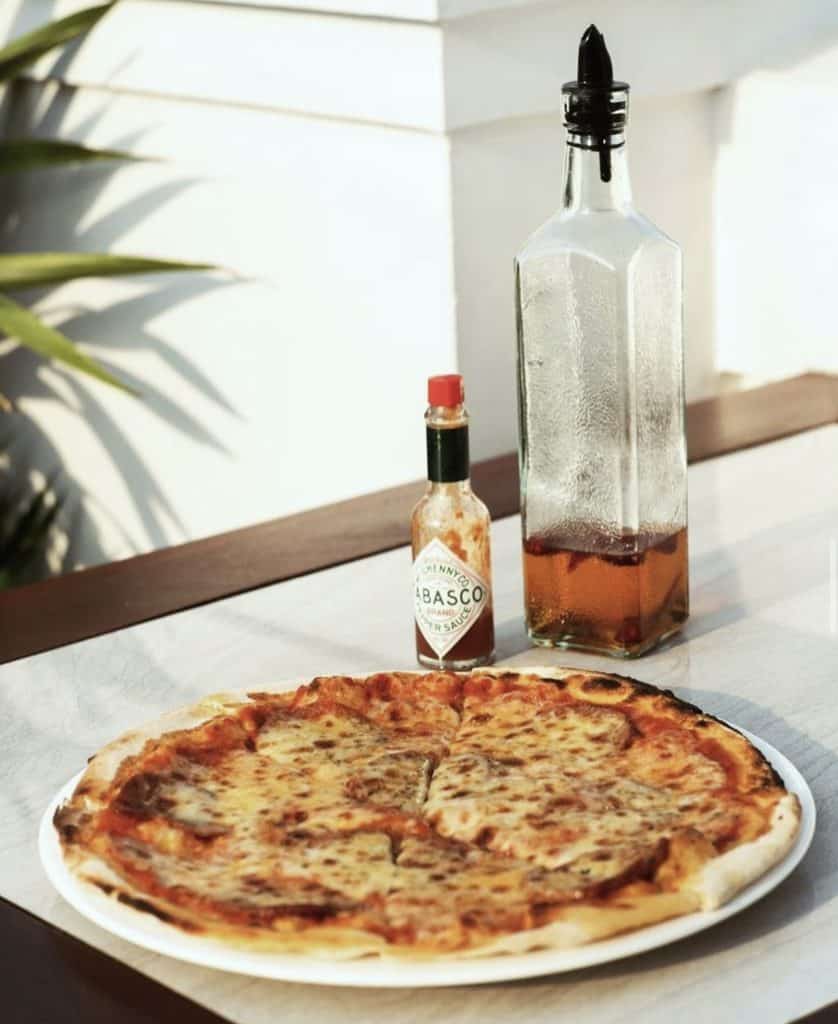
- Market Cafe and Restaurant Lounge at the Hyatt Regency Hotel has a menu with clearly marked gluten free foods. Options include dishes like crab and jicama salad, Dover sole, steak, and more.
- Masala Dosa Street Kitchen is a vegetarian restaurant with dine-in or takeaway, and another gluten free Indian option. They do not have a dedicated gluten free menu, but gluten free foods are clearly marked. Try things like sambar rice bowl, biryani rice bowl with meat kebab, and their delicious dosa. Re-confirm no wheat in the dosa batter.
- Wild Creative Bar & Spring Rolls Restaurant does not have a gluten free menu, but several items are safe to eat. Spring rolls are the specialty here, as the name implies. They also have a location in Siem Reap.
Gluten free restaurants in Siem Reap
- Jomno Modern Khmer Cuisine has a small dedicated gluten free menu, and there are dishes on the regular menu that are safe to eat as well. Fish amok is quite good. They also have river prawn salad, spring rolls, and Cambodian beef tartare.
- Sister Srey Café is a social enterprise in Siem Reap that values good coffee, sustainability and local community development. In their own words, among the reasons to love them is their ability to cater to diverse dietary requirements.
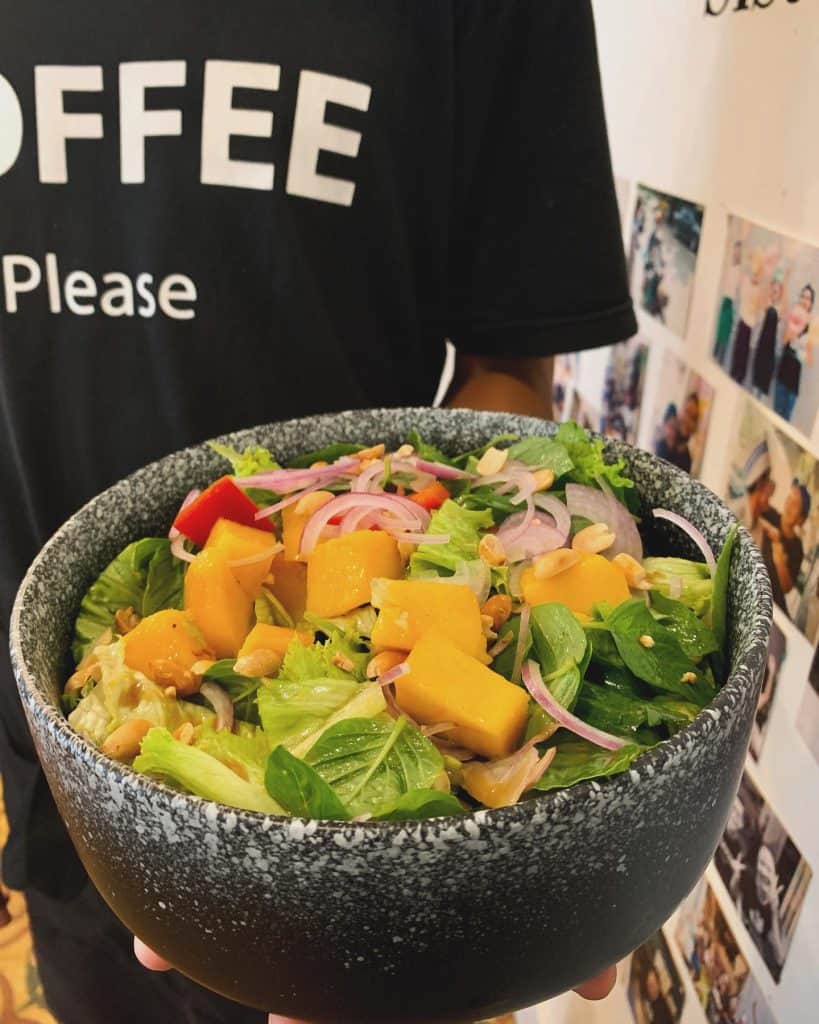
- Crep’Italy, a self-described fusion between a Breton creperie and little Italy, has a a wide variety of dishes and drinks with Italian and French influence, including many gluten free menu items with delicious savoury buckwheat galettes, gluten free pizza, pastas, and desserts, and also serve some Khmer dishes alongside their signatures — many of which can also be made gluten free.
- The Muffin Man has a menu with clearly marked gluten free foods. Some dishes can be made gluten free for a small upcharge. The menu features toasties, sandwiches and cakes. Confirm no CC with preparation, given we’re talking about a bread-based spot.
- Maybe Later Mexican Bar & Grill does not have a dedicated gluten free menu, but they proudly advertise they’re 95% gluten free, vegan, and vegetarian. Try birria tacos, enchiladas, and burrito bowls.
- Elia Greek has one location in Siem Reap (as mentioned above). The restaurant serves delicious traditional foods, which can be made gluten-free by switching out the pita bread for fries or salad.
- The Little Red Fox Espresso Cafe is a charming spot on Hap Guan Street. The menu is quite big, with a few dishes markes as gluten free. Grain bowls and omlettes are the most popular choices.
- The Source Cafe has a menu with clearly marked gluten free foods. They have a nice roasted pumpkin salad, and veggie bowl.
- Haven is a cooking school for disadvantaged youths and restaurant with a health-forward menu. Gluten free dishes are not marked, but the kitchen is very accommodating.
- El Toro Grill is a mix of Cambodia, Mexican, and Italian. There are several gluten free dishes on the menu but they are not marked. The owner is very conscientious about preparing gluten free dishes safely and takes pride in ensure his staff are trained and knowledgable.
- Wild Creative Bar & Spring Rolls Restaurant does not have a gluten free menu, but several items are safe to eat. Spring rolls are the specialty here, as the name implies. They also have a location in Phnom Penh.
- Pou Restaurant & Bar does not have gluten free foods marked on the menu, but there are a few dishes that are safe. The fried rice is delicious and can be made without soy sauce — do confirm no CC on the wok, however.
Gluten free restaurants in Sihanoukville
- Sandan does not have a dedicated gluten free menu but many of their dishes are safe to eat. This restaurant has a wonderful training program for vulnerable youth.
- Seapony Café has a couple of gluten free items marked on their menu. There are a couple extra dishes that are safe if you request no bread on the side, but cross-contact may occur.
- Curry King Indian Restaurant does not have gluten free foods marked on their menu but many of the curries are safe. Check when ordering to ensure there is not cross-contact. They also have locations in Phnom Penh and Siem Reap.
- Robinson Bungalows does not have gluten free dishes marked on the menu but there are a few that should be safe. Be sure to ask if soy sauce is used on the dish and the possibility of cross-contact.
- Bong’s Guesthouse and Bar has limited gluten free items on the menu, but they are clearly marked. It’s a nice little spot near the ocean.
Gluten free restaurants in Kampot
- Epic Arts Cafe is a social enterprise focused on providing training and an inclusive word environment for people with disabilities. The menu has clearly marked gluten free foods like amok.
- Simple Things has gluten free foods marked clearly on the menu. The mango or banana oatmeal is marked gluten free but double check they are used certified gluten free oats before ordering.
- Cafe Espresso Roastery has a couple of gluten free dishes marked on the menu. The best of the two is the rice flour waffles with wok fried eggs, pickled cucumber, sriracha hollandaise and bacon.
- Simon’s Tandoor Indian Restaurant does not have gluten free foods marked on the menu, but many of the curries should be safe. Check that there is no cross-contact before ordering.
- Rikitikitavi does not have gluten free foods marked on the menu, but severak dishes should be safe. Before ordering double check that soy sauce has not been used.
- Ciao does not have gluten free food marked on the menu but the Italian owner to happy to make gluten free pasta and gnocchi. If you are able, give them advance notice. Everything is handmade.
Gluten free restaurants in Battambang
- Jaan Bai in the Central Market area has gluten free food clearly marked on the menu. The fried rice is quite good, and prepared safely. They also have papaya salad, fish amok, and cucumber salad with pork belly.
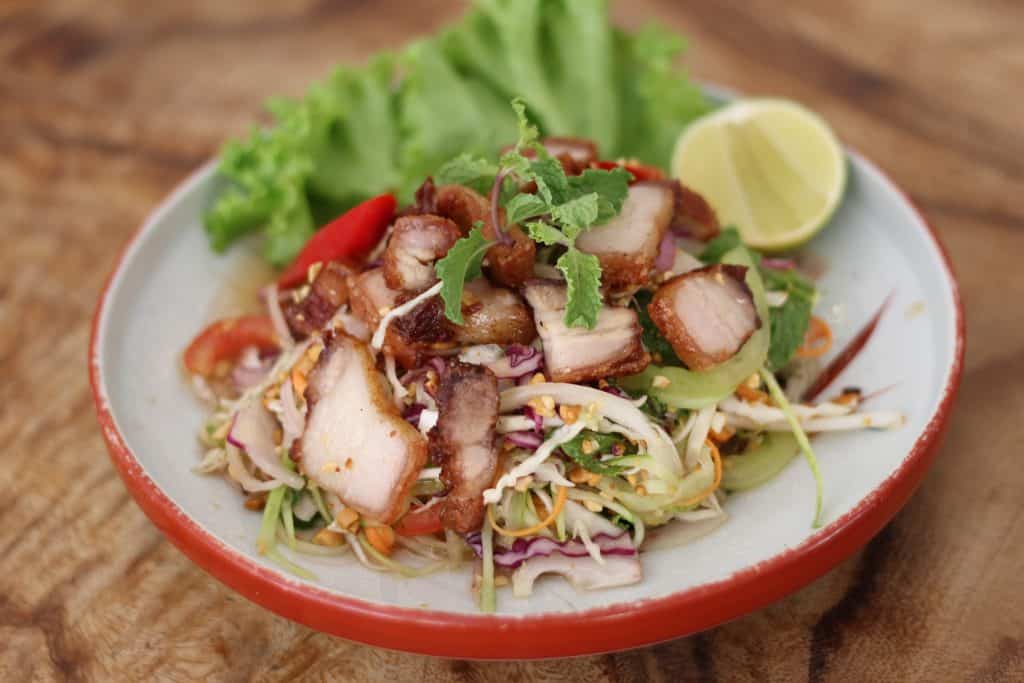
- The Lonely Tree Café does not have gluten free foods marked on the menu but there are several stir fry dishes available. Check that they can prepare without soy sauce, in a clean pan, before ordering.
- The Fringe is a health-forward restaurant with gluten free dishes clearly marked on the menu. They have delicious bowls, but if you order something with barbecued pork make sure the sauce does not have soy sauce in it.
- La Rose is a bakery where most of the foods are gluten free. It’s run by a lovely French lady and everything it homemade.
- Kinyei Cafe is an employee-owned cafe with a tasty menu. The pancakes are made with rice flour and quite good.
If a restaurant you’ve read about in Battambang has been left off this list, it’s because because celiac readers have written in to report cross-contact was an issue.
Gluten free options elsewhere in Cambodia
- Siem Reap Food Tours can serve as a great introduction to Khmer food culture for those unfamiliar, and may even hold surprises for those in the know. These small group tours happen twice a day, and with advance notice, can accommodate gluten free needs. They’re run by a team that includes Lina Goldberg, a long time travel colleague and friend. She confirms that she can ensure us celiacs can eat safely with her!
- Within the Mondulkiri province is Elephant Valley Project, an elephant sanctuary offering both visits and volunteer opportunities. They provide an ever-rotating menu of Khmer and Western meals for guests and volunteers, and are able to provide for celiacs with proper notice.
Further Reading About Cambodia
For those of you looking to visit Cambodia, there are some wonderful books to help inform your visit.
My suggestions for more historical background:
- A Record of Cambodia: The Land and its People is perhaps the oldest surviving historical account of Cambodia, written in 1296-7 by Chinese traveller Zhou Daguan. Daguan, through adept translator Peter Harris, offers descriptions of Angkor civilization in its prime, from architecture, flora, and fauna to the daily habits of 13th century Cambodians, this is a fascinating glimpse into a long-gone culture and a must read for visitors to Cambodia.
- Elizabeth Becker, author of When the War Was Over: Cambodia and the Khmer Rouge Revolution, was one of a only a few Western journalists present in Cambodia during the Khmer Rouge period, and she brings her unique insight to this riveting account of modern Cambodian history. A great feat of journalism and a worthy read for anyone travelling to Cambodia.
- First They Killed My Father is a firsthand account of life under the Khmer Rouge by Loung Ung, a survivor of the Cambodian genocide. Ung was only a small child when Pol Pot’s regime began, and this brutal but beautiful story traces the many horrors she witnessed before escaping with her brother to the United States.
My suggestions for food books:
- NHUM – Recipes from a Cambodian Kitchen from Cambodia’s first female celebrity chef, Chef Nak, is a recipe book that combines traditional Cambodian home cooking with explanations about the country’s rich culinary history. Recipes are details, and photos abound.
- The Food and Cooking of Cambodia by Ghillie Basan offers classic recipes and beautiful photographs, but also a history of the many influences on Cambodian gastronomy. India, China, Burma, Vietnam and Thailand all play a role in shaping Cambodian cuisine, and this cookbook gives you an opportunity to experience it all in your own kitchen.
* * *
Happy and safe eating!
-Jodi
